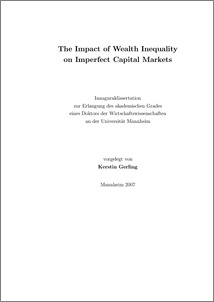|
The impact of wealth inequality on imperfect capital markets
Gerling, Kerstin
![[img]](https://madoc.bib.uni-mannheim.de/style/images/fileicons/application_pdf.png)  Vorschau |
|
PDF
Gerling_Diss2007_NEW.pdf
- Veröffentlichte Version
Download (1MB)
|
|
URL:
|
https://madoc.bib.uni-mannheim.de/1908
|
|
URN:
|
urn:nbn:de:bsz:180-madoc-19084
|
|
Dokumenttyp:
|
Dissertation
|
|
Erscheinungsjahr:
|
2007
|
|
Titel einer Zeitschrift oder einer Reihe:
|
None
|
|
Ort der Veröffentlichung:
|
Mannheim
|
|
Hochschule:
|
Universität Mannheim
|
|
Gutachter:
|
Grüner, Hans Peter
|
|
Datum der mündl. Prüfung:
|
11 Dezember 2007
|
|
Sprache der Veröffentlichung:
|
Englisch
|
|
Einrichtung:
|
Fakultät für Rechtswissenschaft und Volkswirtschaftslehre > VWL, Wirtschaftspolitik (Grüner 1999-)
|
|
Fachgebiet:
|
330 Wirtschaft
|
|
Fachklassifikation:
|
JEL:
D31 D82 D40 F36 O12 D53 ,
|
|
Normierte Schlagwörter (SWD):
|
Kapitalmarkttheorie , Ungleichheit , Unvollkommene Information , Wirtschaftswachstum
|
|
Freie Schlagwörter (Deutsch):
|
Internationale Finanzmarktintegration , Unvollständiger Bankenwettbewerb
|
|
Freie Schlagwörter (Englisch):
|
Capital Market Theory , Inequality , Incomplete Information , Growth , Banking Market Power , International Financial Integration
|
|
Abstract:
|
This dissertation contributes to the analysis of the macroeconomic impact of wealth inequality on imperfect capital markets. The analysis assesses its occurrence and consequences in a general equilibrium framework with wealth heterogeneity among agents and a convex technology. The essential point is that because of the commitment value of wealth on imperfect capital markets, productive opportunities might vary along the wealth distribution via access to credit. Thus, the larger the fraction of society whose financial constraint is binding, the more the capital allocation and the production outcome deviate from their full information counterparts. In each of the three substantive Chapters, the setting is adapted to focus on a specific aspect of the role of inequality: its impact on (i) growth when explicitly allowing for autarkic production, (ii) efficiency when coupled with banking market power as an additional market friction and (iii) the beneficence of international financial integration when countries are heterogeneous. Chapter 2 dynamizes the basic model, in order to show how productive inefficiencies affect the evolution of inequality and how they lead to a multiplicity of steady-states, which depend on initial conditions. However, taking into account the possibility of autarkic production allows identifying the existence of credit-constrained net lenders. The fact that they profit from high interest rates countervails the poor's pauperization, changes distributional dynamics and thus the convergence to the bad steady-state. Extending the static setting, Chapter 3 challenges what hitherto models typically take for granted: perfect competition on the deposit and loan market. Among others, banking market power triggers the existence of autarkic entrepreneurs in equilibrium, but might also help to solve the imperfect information problem and consequently to restore the first-best outcome. In this context, inequality is found to be constraining the scope of banking market power. Likewise through the imperfect capital market lens, Chapter 4 finally scrutinizes the real consequences of financial market integration. It dismantles credit rationing as a new cost of financial market integration and shows that inequality provides higher absorptive capacities for capital inflows after external financial liberalization.
|
|
Übersetzter Titel:
|
Die Auswirkungen von Vermögensungleichheit auf unvollkommenen Kapitalmärkten
(Deutsch)
|
|
Übersetzung des Abstracts:
|
Diese Dissertation untersucht die makroökonomischen Auswirkungen von Vermögensungleichheit auf unvollständigen Kapitalmärkten. Ihre Ursachen und Konsequenzen werden in einem allgemeinen Gleichgewichtsmodell mit individueller Vermögensungleichheit und einer konvexen Produktionstechnologie hergeleitet. Der zentrale Punkt ist, dass die Produktionsmöglichkeiten der Individuen aufgrund der Bindungskraft von Vermögen auf unvollständigen Kapitalmärkten entlang der Vermögensverteilung durch den Zugang zum Kreditmarkt variieren können. Je größer der Bevölkerungsanteil, welcher der Kreditrationierung aufgrund fehlender Sicherheiten zum Opfer fällt, desto mehr weichen die Kapitalallokation und das Produktionsergebnis von den entsprechenden Werten unter vollständiger Information ab. Dieser Rahmen wird in jedem der drei Hauptkapitel angepasst, um den Fokus auf einen spezifischen Aspekt der Rolle von Ungleichheit zu legen. Insbesondere erfolgt die Analyse ihrer Auswirkungen auf (i) das Wirtschaftswachstum, wenn autarke Produktion explizit Berücksichtigung findet, (ii) die Effizienz, wenn neben Ungleichheit unvollständiger Bankenwettbewerb als weitere Verzerrung vorliegt und (iii) die Vorteilhaftigkeit von internationaler Finanzmarktintegration, wenn Länder heterogen sind. Kapitel 2 dynamisiert das Basismodell, um zu zeigen, wie Produktionsineffizienzen die Entwicklung von Ungleichheit und Wachstum beeinflussen und wie sie zu einer Vielzahl an von den Startwerten abhängigen Steady-States führen. Jedoch erlaubt die Berücksichtigung einer autarken Produktionsform die Existenz kreditrationierter Nettokreditgeber aufzudecken. Dass sie von hohen Zinsen profitieren, wirkt der Verarmung der Mittellosen entgegen, verändert die Verteilungsdynamik und damit die Konvergenz zum schlechten Steady-State. Die Erweiterung des statischen Ursprungsmodells in Kapitel 3 stellt in Frage, was bisherige Modelle stets als selbstverständlich angenommen haben: vollständiger Wettbewerb auf dem Markt für Spareinlagen und Kredite. Unter anderem zieht die Marktmacht von Banken die Existenz autarker Unternehmer im Gleichgewicht nach sich, trägt aber auch zur Lösung des Problems der unvollständigen Information bei und kann damit das first-best Ergebnis wieder herstellen. In diesem Kontext begrenzt Ungleichheit das Ausmaß der Marktmacht von Banken. Schließlich hinterfragt Kapitel 4 die realen Konsequenzen von Finanzmarktintegration auf unvollständigen Kapitalmärkten. Es deckt Kreditrationierung als neue Kosten der Finanzmarktintegration auf und zeigt u.a., dass eine relativ höhere Vermögensungleichheit Absorptionskapazitäten für Kapitalzuflüsse schafft.
(Deutsch)
|
 | Dieser Eintrag ist Teil der Universitätsbibliographie. |
 | Das Dokument wird vom Publikationsserver der Universitätsbibliothek Mannheim bereitgestellt. |
 Suche Autoren in Suche Autoren in
Sie haben einen Fehler gefunden? Teilen Sie uns Ihren Korrekturwunsch bitte hier mit: E-Mail
Actions (login required)
 |
Eintrag anzeigen |
|
